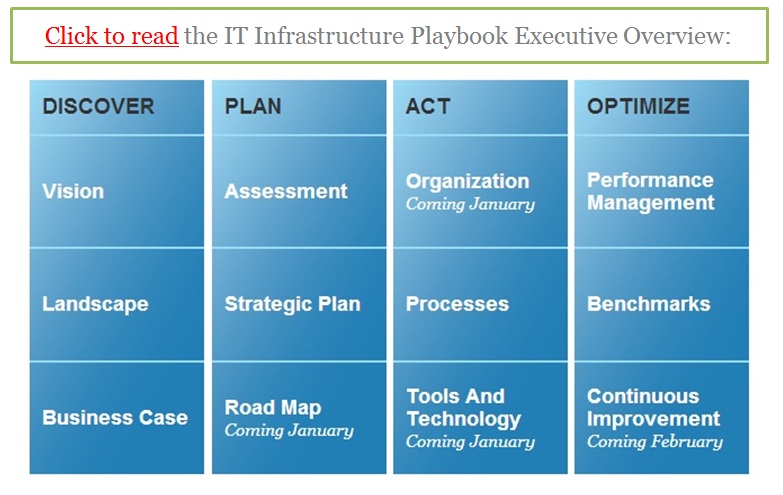The Future of IT Infrastructure And Data Centers: A New Wave Of Consolidation And Optimization
Like a song stuck on repeat, enterprise IT hardware decision makers tell Forrester once again that consolidation and optimization top their list of priorities into 2014. According to Forrester's Q3 2013 Hardware survey, 77% deem server, storage and network virtualization and consolidation a high or citical priority—followed by 68% who prioritize the automating the management of virtualized servers to gain flexibility and resiliency. Conslidation + Optimization.
But what's new this time around is that the next wave of IT infrastructure and data center consolidation and optimization requires a new approach centered around workload-centric, software-defined, and hybrid cloud. If you're an IT infrastructure and operations (I&O) professional tasked with IT infrastructure and data center strategy, it's time to incorporate these themes into your approach:
- Application-centric infrastructure optimizes infrastructure around what matters most. For too long, IT infrastructure has aligned to silos of technology, resulting in complexity, low satisfaction, poor communication, and wasted money. To deliver better business results over the next decade, Forrester advocates that you take an application-centric (or workload-centric) approach: Design your IT infrastructure to fit the apps and workloads that are critical to customers.
- Software-defined infrastructure amplifies consolidation and developer access. Software-defined infrastructure is an emerging architecture that pools compute, storage and network resources together and makes them accessible through APIs or service catalogs. This new architecture will amplify your consolidation potential since it relies of extensive virtualization, automation and orchestration while giving developers and business owners easier access to infrastructure resources.
- Hybrid cloud management increases your relevancy in the cloud era. Enterprise infrastructure is now a hybrid mix of public and private clouds. For example, while I&O professionals say that only 7% of their x86 OS instances will run in a public Infrastructure-as-a-Service (IaaS) cloud by 2016—24% of enterprise software developers already use public IaaS regularly. So who will manage this hybrid portfolio? I&O pros have a good shot, but must earn the right by retooling their traditional data center infrastructure skills to focus on the app tier.
Forrester's IT Infrastructure Playbook, which launched today, can help you get started. This Playbook brings together research, analysis and advice from Forrester's leading IT infrastructure analysts, including: Richard Fichera (servers), Henry Baltazar (storage), Andre Kindness (networks), Dave Bartoletti (virtualization, hybrid cloud), Sophia Vargas (data center economics), and Rachel Dines (resiliency).
Our playbook offers a four-phased approach—Discover, Plan, Act and Optimize—to help I&O leaders consolidate and optimize their IT infrastructure and data centers across their server, storage, network, virtualization and data center facilities, from start to finish.
Click here or below to read a complementary copy of IT Infrastructure Executive Overview:
Phase 1 – Discover The Trends, Examine The Landscape, And Build Your Case
Before starting—or revamping—IT infrastructure consolidation, convergence and optimization programs, I&O leaders must understand the long-term trends, how the landscape is changing, and assemble the business cases. The "discover" phase of the IT Infrastructure playbook helps you answer the following questions:
– Vision: If the future of IT infrastructure is “software-defined”—is it truly reflected in my strategy?
– Landscape: Is my IT infrastructure designed around the application—or the other way around?
– Business Case: How do I develop the case for my most important IT infrastructure investments?
Phase 2 – Plan By Assessing Your Maturity, Develop Strategic Plans And Road Maps
After developing a vision of the future of IT infrastructure, I&O leaders must assess their current capabilities and gaps and then develop their strategic plans and road maps. The “plan” phase of the IT Infrastructure playbook helps you answer the following questions:
– Assessment: How mature are my infrastructure people, processes, technology and facilities?
– Strategic Plan: Does my IT infrastructure strategic plan reflect business and developer goals?
– Road Map: Do my road maps reflect hybrid, software-define and workload-centric imperatives?
Phase 3 – Act On Your Organization, Process, And Technology Strategies
Strategy in hand, I&O leaders are now ready to execute on their IT infrastructure plans with confidence. The "act" phase of the IT Infrastructure helps you answer the following questions:
– Organization: What new skills does my team need to thrive in a "hybrid" cloud world?
– Process: What processes can I learn from the cloud giants who operate infrastructure at scale?
– Tools and Technology: Should I build or buy? Which vendors and providers should I evaluate?
Phase 4 – Optimize Your Performance, Benchmark Your Strategy, And Improve
Planning and investing in new or improved people, process and technology is just the first step to a more consolidated, converged and optimized IT infrastructure practice. The “optimize” phase of the IT Infrastructure playbook helps answer the following questions:
– Performance Metrics: How do I develop my Balanced Scorecard for IT infrastructure?
– Benchmarks: How do my strategic IT infrastructure benchmarks compare to my peers?
– Continuous Improvement: How do I instill a culture of continuous improvement?
Doug Washburn is a Research Director on Forrester's IT Infrastructure & Operations research team. Follow him on Twitter here @dougwashburn.
